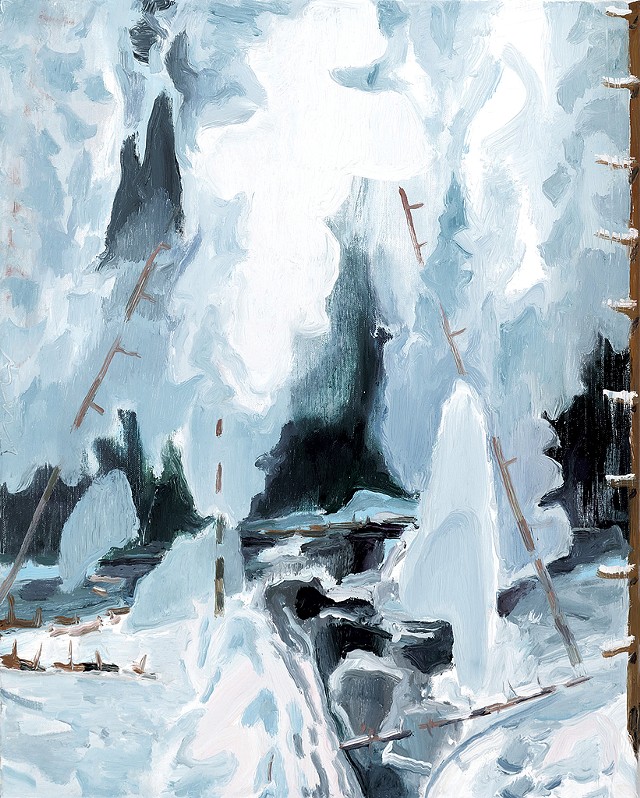
- Courtesy of Rachel Portesi
- "Small Winter Stream," 2021
The woods, streams, ponds and small waterfalls of the Northeast don't typically inspire a sense of monumentality. Yet Eric Aho manages to make them so in "Headwater," an exhibition of new work at the BCA Center in Burlington by the established Saxtons River painter.
On mostly large canvases — measuring up to 78 by 70 inches — oil landscapes extend in a vertical sweep from glimpses of sky and clouds through towering pines to foregrounded jumbles of rocks and downed trees. In each composition, a water feature appears at the center: a cascade, a forest pool, a gurgling winter stream.
The scale recalls the Hudson River School's grandiose depictions of nature — a comparison Aho has made himself in interviews. But in his case, the grandiosity issues from the profusion of bold brushwork and exuberant color. Through these two elements, Aho performs a kind of fusion of the representational and the abstract. In so doing, he elides the process of painting with the process of looking at nature.
As Aho, a Massachusetts native with Finnish roots, explained during a phone call, he has never been able to work solely in abstraction or representation.
"It doesn't align with how I or, really, anyone sees the world," he said. "Looking is creating a record, but it's also a confusion, a bewilderedness. You can see the world in a fragmented way. The act of painting is akin to the act of looking."
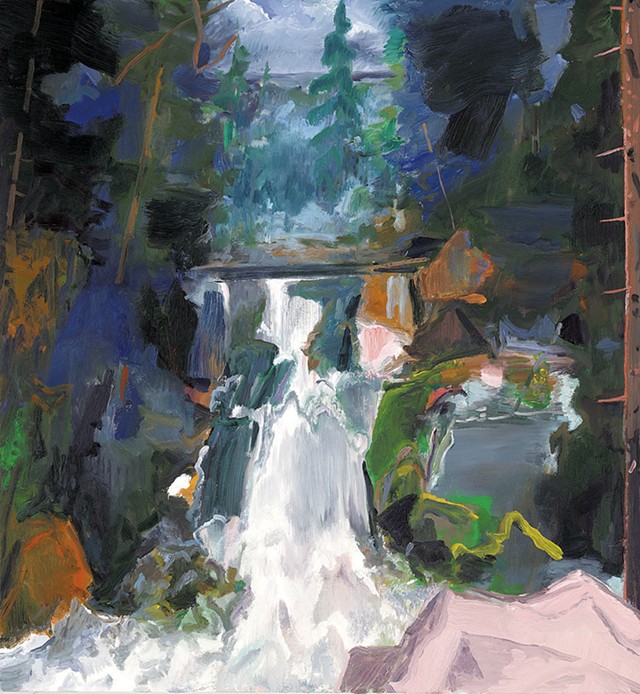
- Courtesy of Rachel Portesi
- "Falls and a Pool in the Forest," 2021
"July Pond," at 60 by 52 inches, readily illustrates the point. The top of the canvas depicts a sunny day while an inscrutable pink haze at its center is perhaps a stand of shorter trees hit by late-afternoon light. Abstraction takes over in the pond at the bottom, discernible only through submerged, multicolored tree stumps and their angled reflections. These join to form flat, unexpectedly geometric shapes.
Aho generally skis or walks the woods around his studio and either begins a painting en plein air or returns indoors to re-create a scene from memory. During the pandemic, he muted the size and palette of his work; the current crop is a "return to scale," as he put it, and a venture into new hues, including golden yellows and ochers.
The latter are the dominant tones of "Tamarack," painted during the fall when the trees turn a brilliant yellow. Aho's work is governed by the seasons: "I can't imagine painting a winter scene in summer," he said. The colors are so actively applied that they could as well depict a forest on fire, particularly with the black tree stumps tilting in the foreground. (In fact, Aho made a series of J.M.W. Turneresque forest fire paintings in the late aughts.)
Globs of a purer yellow, perhaps straight out of the tube, dot the canvas and, in one thickly painted corner, the artist scrawled the date of the work's completion with the sharp end of a brush. The physicality of paint is clearly an interest.
So are the canvases' boundaries. In two paintings, "Falls and a Pool in the Forest" and "Small Winter Stream," a bare pine trunk notched with broken branches is painted along the vertical right edge, as if to frame the scene.
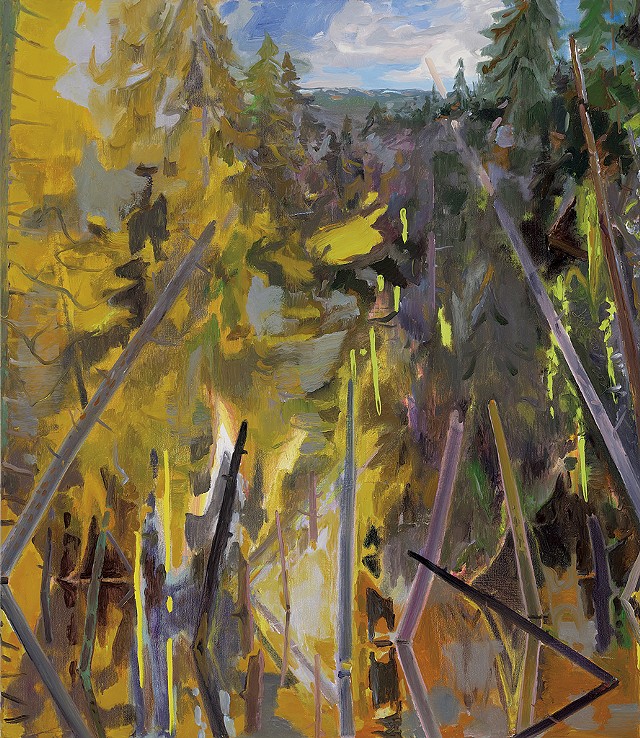
- Courtesy of Rachel Portesi
- "Tamarack," 2021
"I would like the canvases to go on forever, but they have to have an edge," Aho admitted. "The canvas feels a little bigger if I can give the sense of looking past [the tree]."
"Americana" is a subdued and elegant composition with dark shapes and shadows framing a smooth plane of falling water. The painting depicts a former mill pond, according to Aho. Its title refers to the collection of natural elements on display — forest, water — as signifiers of the culture, given that those elements were once shaped by human labor.
"Witness," one of the largest canvases, frames a small waterfall and rapids between glimpses of a rosy-hued sky and massive pink boulders. Two downed spruce trunks form a cross in the foreground. The painting's subject is out of the frame: the witness tree, an oak whose only presence is a twisting branch at the top left corner.
Witness trees, often hundreds of years old, are named for their sentinel presence through all manner of natural and human events. The painting's title has the effect of eliding the two witnesses — tree and viewer — who observe the scene through the eyes of its original witness, the painter.
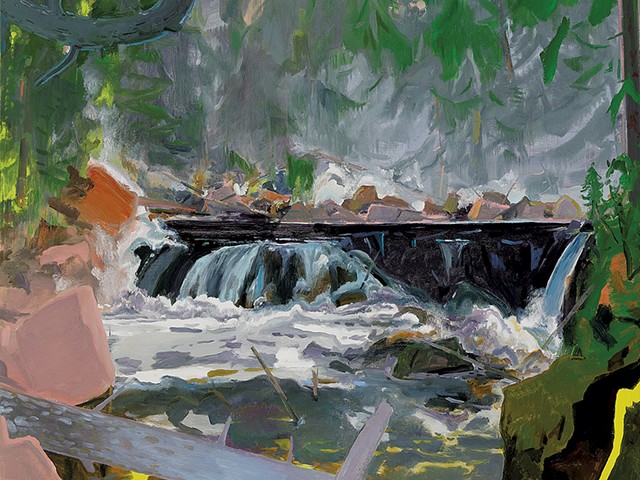
- Courtesy of Rachel Portesi
- "Witness," 2021
Aho earned his bachelor's degree in printmaking and had studied painting for only one year of graduate school when he moved to Vermont to teach painting at the Putney School in 1989. At that point, he recalled, "I was making loose drawings with oil paint, not really painting. It remained an undefined experience until later. I'm still not even sure what it is."
Aho's fearless, assured experiments in the medium have nevertheless earned him many awards, as well as holdings in major institutions, including the Museum of Fine Arts in Boston, the Metropolitan Museum of Art in New York City, and museums in Cuba, Norway, Finland, South Africa and elsewhere.
Aho came to this viewer's attention in 2016, when he won the Vermont Governor's Award for Excellence in the Arts and, in the same year, had a solo exhibit at the Hood Museum of Art at Dartmouth College featuring a series of paintings called "Ice Cuts." They depict a square hole that Aho had cut with a saw in a frozen pond for plunging, a Finnish post-sauna ritual. The paintings seem to channel Mark Rothko with their geometric, unfathomably black squares. They are utterly different from the work in the BCA show.
"[Painting] is ridiculously magical and surprising," Aho commented. "Something remarkable happens when you put one color next to another."
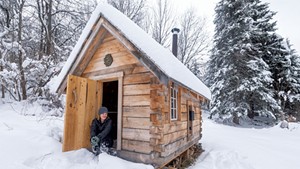









Comments
Comments are closed.
From 2014-2020, Seven Days allowed readers to comment on all stories posted on our website. While we've appreciated the suggestions and insights, right now Seven Days is prioritizing our core mission — producing high-quality, responsible local journalism — over moderating online debates between readers.
To criticize, correct or praise our reporting, please send us a letter to the editor or send us a tip. We’ll check it out and report the results.
Online comments may return when we have better tech tools for managing them. Thanks for reading.